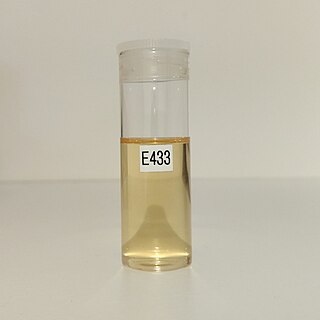
Pantothenic acid (vitamin B5) is a B vitamin and an essential nutrient. All animals need pantothenic acid in order to synthesize coenzyme A (CoA), which is essential for cellular energy production and for the synthesis and degradation of proteins, carbohydrates, and fats.

Folate, also known as vitamin B9 and folacin, is one of the B vitamins. Manufactured folic acid, which is converted into folate by the body, is used as a dietary supplement and in food fortification as it is more stable during processing and storage. Folate is required for the body to make DNA and RNA and metabolise amino acids necessary for cell division and maturation of blood cells. As the human body cannot make folate, it is required in the diet, making it an essential nutrient. It occurs naturally in many foods. The recommended adult daily intake of folate in the U.S. is 400 micrograms from foods or dietary supplements.

Sorbitol, less commonly known as glucitol, is a sugar alcohol with a sweet taste which the human body metabolizes slowly. It can be obtained by reduction of glucose, which changes the converted aldehyde group (−CHO) to a primary alcohol group (−CH2OH). Most sorbitol is made from potato starch, but it is also found in nature, for example in apples, pears, peaches, and prunes. It is converted to fructose by sorbitol-6-phosphate 2-dehydrogenase. Sorbitol is an isomer of mannitol, another sugar alcohol; the two differ only in the orientation of the hydroxyl group on carbon 2. While similar, the two sugar alcohols have very different sources in nature, melting points, and uses.
A nutrient is a substance used by an organism to survive, grow and reproduce. The requirement for dietary nutrient intake applies to animals, plants, fungi and protists. Nutrients can be incorporated into cells for metabolic purposes or excreted by cells to create non-cellular structures such as hair, scales, feathers, or exoskeletons. Some nutrients can be metabolically converted into smaller molecules in the process of releasing energy such as for carbohydrates, lipids, proteins and fermentation products leading to end-products of water and carbon dioxide. All organisms require water. Essential nutrients for animals are the energy sources, some of the amino acids that are combined to create proteins, a subset of fatty acids, vitamins and certain minerals. Plants require more diverse minerals absorbed through roots, plus carbon dioxide and oxygen absorbed through leaves. Fungi live on dead or living organic matter and meet nutrient needs from their host.

Surfactants are chemical compounds that decrease the surface tension or interfacial tension between two liquids, a liquid and a gas, or a liquid and a solid. The word "surfactant" is a blend of surface-active agent, coined in 1950. As they consist of a water-repellent and a water-attracting part, they enable water and oil to mix; they can form foam and facilitate the detachment of dirt.

Fumaric acid or trans-butenedioic acid is an organic compound with the formula HO2CCH=CHCO2H. A white solid, fumaric acid occurs widely in nature. It has a fruit-like taste and has been used as a food additive. Its E number is E297. The salts and esters are known as fumarates. Fumarate can also refer to the C
4H
2O2−
4 ion (in solution). Fumaric acid is the trans isomer of butenedioic acid, while maleic acid is the cis isomer.
Linoleic acid (LA) is an organic compound with the formula HOOC(CH2)7CH=CHCH2CH=CH(CH2)4CH3. Both alkene groups are cis. It is a fatty acid sometimes denoted 18:2 (n−6) or 18:2 cis-9,12. A linoleate is a salt or ester of this acid.

Polysorbates are a class of emulsifiers used in some pharmaceuticals and food preparation. They are commonly used in oral and topical pharmaceutical dosage forms. They are also often used in cosmetics to solubilize essential oils into water-based products. Polysorbates are oily liquids derived from ethoxylated sorbitan esterified with fatty acids. Common brand names for polysorbates include Kolliphor, Scattics, Alkest, Canarcel, Tween, and Kotilen.
Emulsifying wax is a cosmetic emulsifying ingredient. The ingredient name is often followed by the initials NF, indicating that it conforms to the specifications of the National Formulary.

Polysorbate 80 is a nonionic surfactant and emulsifier often used in pharmaceuticals, foods, and cosmetics. This synthetic compound is a viscous, water-soluble yellow liquid.
Sorbitan monostearate is an ester of sorbitan and stearic acid and is sometimes referred to as a synthetic wax.

Sorbitan is a mixture of isomeric organic compounds derived from the dehydration of sorbitol and is an intermediate in the conversion of sorbitol to isosorbide. Sorbitan is primarily used in the production of surfactants such as polysorbates; which are important emulsifying agents, with a total annual demand of more than 10,000 tons in 2012. Sorbitan and Sorbitol esters are an uncommon allergen.

Sorbitan tristearate is a nonionic surfactant. It is variously used as a dispersing agent, emulsifier, and stabilizer, in food and in aerosol sprays. As a food additive, it has the E number E492. Brand names for polysorbates include Alkest, Canarcel, and Span. The consistency of sorbitan tristearate is waxy; its color is light cream to tan.
Sodium lauroyl sarcosinate (INCI), also known as sarcosyl, is an anionic surfactant derived from sarcosine used as a foaming and cleansing agent in shampoo, shaving foam, toothpaste, and foam wash products.
Monolaurin (abbreviated GML; also called glycerol monolaurate, glyceryl laurate, and 1-lauroyl-glycerol) is a monoglyceride. It is the mono-ester formed from glycerol and lauric acid. Its chemical formula is C15H30O4.

MimicCreme was a brand of vegan imitation cream based on nuts and made without lactose, soy, or gluten. It was certified as pareve kosher. First produced commercially in January 2007 in Albany, New York, by Green Rabbit LLC, MimicCreme was primarily marketed toward vegans as an alternative to dairy products. The company website indicates that the company closed in November 2013 due to no longer having access to an appropriate production facility.
Sorbitan monooleate is a food additive with the E number E494.

Fabric treatments are processes that make fabric softer, or water resistant, or enhance dye penetration after they are woven. Fabric treatments get applied when the textile itself cannot add other properties. Treatments include, scrim, foam lamination, fabric protector or stain repellent, anti microbial and flame retardant.

Oatmeal creme pies were the first Little Debbie snack cake commercially produced by McKee Foods. The snack consists of two soft oatmeal cookies stuffed with fluffy creme filling.












